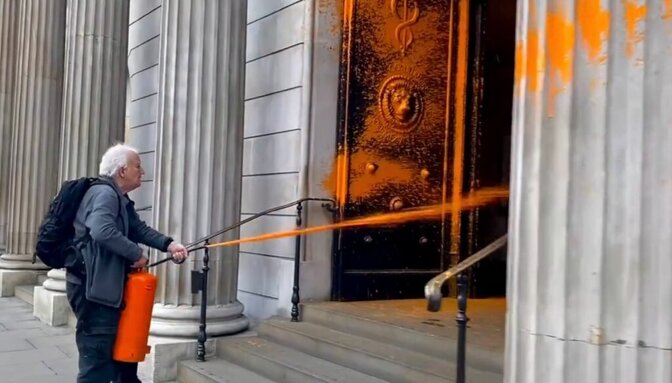These past few months, actions from climate activists have been divinding public opinion, and for some people, this kind of activism could even be counterproductive.
True, throwing soup on the glass protecting a Van Gogh painting, or sitting in the middle of the road to disrupt the Tour de France isn’t everyone’s cup of tea. Tens of thousands of people have thus explained on social media that this was all counterproductive. Amazingly, researchers specialising on activism, who have studied these actions for decades, don’t even know themselves if they’re efficient or hindering. Do you know how lucky we are to have so many omniscient people capable of seeing the future?
For other people, those who can’t see the future through crystal balls, the present article summarises what we know about the radicalisation of some actions, and how to interpret them.
What types of activism make the news?
The forms activism can take have evolved in recent months. While we were accustomed to see climate demonstrations and walks, or AGMs disrupted by activists, it appears new methods have overcome them, at least in the media. You might have heard of a sports competition recently interrupted by Derniere Renovation, of people bursting SUV tires, or two activists who threw soup at a glass window protecting a Van Gogh painting.
It’s no surprise that how activism presents is evolving. Dana Fisher, author of the IPCC Group 3 and activism researcher, adds that “we are witnessing the continuation of young people’s worries about the climate crisis (…) because institutional politics is not working. We can say exactly the same thing about the first waves of the Civil Rights movement, where we’ve obtained some concessions but no true systemic change.”

A shapeshifting mediatisation
The majority of targets are highly-mediatised events or symbolic places, such as the Bank of England sprayed in orange paint. It’s not a coincidence: requiring few means and little preparation, a greater audience can be reached. Climate protests with tens of thousands of people walking get little to no attention. However, a roadblock or occupying a building appears much more efficient at attracting media’s attention.
Such was the case for the video depicting soup being thrown “on” a Van Gogh, with its millions of views upon release and an international news coverage. The attention is however completely different when scientists protest, lying on roads or gluing their hands to cars to alert on climate change. Reactions are indeed far from the thousands when these scientists take part in pacific action.
This time, no media expert to demonstrate how counterproductive these actions are.

What’s the aim of this more radical activism?
Activists and scientists get involved in action for various reasons. It can be to raise awareness, generate attention to a particular subject, push undecisive people to action, or lead the way towards other more or less radical action.
As opposed to what may be stated by some news outlets, these actions are well-thought through. These protests are carried out because those activists and scientists know that any additional report explaining climate warming and biodiversity collapse will not change anything. Policy-makers simply won’t listen.
Reducing these people to “they want TikTok likes” makes no sense. I don’t think Julia Steinberger, author on the latest IPCC report, is having much fun lying down on a road, being arrested, risking a trial, and suffering fom insults and death threats everyday.
The same goes for these young activists. Do you really think they’re enjoying being insukted every day? Probably not. But it’s the price to pay for the fight for climate to exist in the media and for people to keep talking about it.

Even if radical actions receive less support from the wider public, their presence in the media is that much more significant that the impact becomes greater anyway. But what is this impact, and to what aim?
Radical flank effect
It might be counterintuitive at first, but the recent, most radical actions from activists are not meant to change public opinion. Their goal is that of all radical flank for decades: increasing the support for actions perceived as more moderate. This strategy has been trialled and approved by several social movements (not just climate-related), and is very well-documented in Andreas Malm’s insightful book, How to Sabotage a Pipeline.
As opposed to the radical flank, moderate actions can positively influence public opinion, benefit from a greater financial support or simply push hesitant people to join the movement. If you read the comments under the latest actions, you will systematically encounter comments such as “so dumb to throw soup on art, you better go protest in front of Total! Not in a shit museum!”. While some may have commented emotionally, it is likely these actions attract more sympathy if they target climate criminals.

According to Dana Fisher, the radical flank plays a key role in the efficiency of the climate movement: “This kind of action does not aim to change hearts and minds, but to mobilise people already adhering to the cause”. A number of studies such as Simpson et al. (2022), Shuman et al. (2022) and Budgen (2020), believe that a radical kind of action (such as those carried out by Derniere Renovation and Just Stop Oil) have a greater impact than climate demonstrations. This is what Rob Willer, in The Activists’s Dilemma, reminds us: a traditional protest, disrupting no one, will never give you the media’s attention on the international scene and is unlikely to reach outside the environmental activists’ bubble.
Activism, Overton window and Benny Hill
While this radical flank has seen some success, it’s underlying goal is also to shift the Overton window. The Overton window is an “allegory placing a group of ideas, opinions or practices considered more or less acceptable by public opinion in a society”. While some actions may appear extreme or too radical the first few times, not only can habit make them appear less “violent” to the wider public’s eyes, it can also make actions that weren’t previously adhered to by most of the population appear less violent.
However, the radical flank can only have this effect if the public can distinguish between the radical and the moderate flanks. This shouldn’t be too difficult to do lately, if you pay attention to the various actions. The latest being those activists who tried to stop private jets from taking off, has for example been highly successful and made people laugh on social media…
It’s impossible to tell whether it’s counterproductive
Let’s answer the main question now: are these actions counterproductive? To this aim, we must dive into the scientific literature on the matter. This might not be to everyone’s taste, but the only conclusion you can draw from it, is that to this day it’s impossible to pretend to know if these actions are counterproductive. Those who deny it are only expressing an opinion, which is not based on empirical evidence.
When the IPCC asked Dana Fisher to compile the research investigating the impact of climate activism on greenhouse gases trends, the sociologist concluded that there was not that much to summarise. A few months after the release of the 3rd volume of the latest IPCC report (chapter 13), we are at exactly the same spot. There are many resources measuring climate movements, but few measure their impacts.
Moreover, studies report on what we have observed in the past, in a specific context and location, but they don’t allow to predict the effect of a specific action. They can, at best, show trends. But predicting what will trigger a person into acting is extremely difficult. However, those radical actions don’t change the minds of people who are already committed to the cause. “No one involved in the fight against climate change is going to stop overnight because there are annoying activists. That’s not how people work, even if they pretend it is”, declared Oscar Berglund, activism and civil disobedience researcher.
NB: Like other researchers, Dana Fisher calls for more funding to understand different movements and their strategies to fight climate change. The overall amount of funds dedicated to social sciences of emission attenuation is ridiculously low (0.12% between 1990 ad 2018) compared to other funding.
How could we know if these types of activism are productive?
To assess actions’ efficacy and whether they are productive – and therefore, drive a cultural change or actions fighting against climate change – we need to particularly pay attention to the methodology. Which topic is being discussed? Mobilisation? Activism? Violent action? Civil disobedience? Is a study on social movements appropriate for climate activism? Besides, how to investigate? Through interviews? With what level of knowledge on the climate emergency required from interviewees?
We should first consider the action’s temporality: which feelings prior, during, and after the actions. Then, accounting for the location. Efficacy will thus depend on the cultural environment. You wouldn’t get the same results with a population highly aware of climate change and its consequences, as with a population in which 90% of inhabitants believe the current climate warming is only due to a solar cycle (it’s false).
Then, when reading a study on this topic, we must clarify whether the work is peer-reviewed, but especially, keep in mind that a 2018 study is potentially outdated in 2022. The feeling of climate emergency is evolving and, although slow, awareness has seen an increase since 2018.
Time is running out
Finally, who is an action’s target? Are you trying to convince public opinion (which must still be defined)? Other activists, like the radical flank? Policy makers? And, if you gain support from the majority of the population, will it be enough for policy makers to act and change the economic model, or laws?
To conclude, we can’t know if an action has been productive or counterproductive before some time has passed. According to Dana Fisher, “the point of an action such as the thrown soup is attention and communication, not only about the act itself but through everything that follows. In any case, it’s not determined by the action itself.”
I don’t know whether we should wait for historian to assess in 2050 whether these actions were counterproductive.
Time is running out
Finally, who is an action’s target? Are you trying to convince public opinion (which must still be defined)? Other activists, like the radical flank? Policy makers? And, if you gain support from the majority of the population, will it be enough for policy makers to act and change the economic model, or laws?
To conclude, we can’t know if an action has been productive or counterproductive before some time has passed. According to Dana Fisher, “the point of an action such as the thrown soup is attention and communication, not only about the act itself but through everything that follows. In any case, it’s not determined by the action itself.” I don’t know whether we should wait for historian to assess in 2050 whether these actions were counterproductive.
Media representation and ecoterrorism
If one thing has a fundamental influence on opinion, it’s information. We already know that media coverage of climate change is lacking, not only quantitatively but qualitatively too. When these actions are mentioned on TV, channels systematically discuss the means, not the message.
The message is the urgent need to change our economic model. To change all aspects of life. The way we eat, the way we move, how we stay warm. This is what the IPCC reminds us in its latest report. We need “fundamental changes in society’s functioning, including its underlying values, its view of the world, social structures, political and economic systems and power relationships.”
If news channels, journalists, editorials and politics constantly repeated this message, these actions clearly wouldn’t be perceived the same way. Before polling the public, present them with the message, the governments’ inaction, the lies from companies like Total, then start the poll.
Civil disobedience and violence
Violence has been at the heart of discussions over the past few weeks. The word ahs been repeated on a loop, until Minister of the Interior Gerald Darmanin began to talk about ecoterrorism, a term then reused by the presidential majority and Twitter Trends for several days.
This choice of word and its context are of particular interest. Never is it used when fossil fuel companies, with the support of states, exploit new gas and oil fields, which will make us fall short of the Paris Agreement’s goals and will condemn part of Humanity. This is not violence. But an activist throwing soup on a glass window is violent, and a terrorist act.
This year 2022 is the perfect scene to put into light the media’s treatment of the so-called “radical” actions of climate activists. An activist interrupts Roland-Garros: thought “terrorist”, “little bohemian cunt”, “lunatic”. Thousands of people died from the heatwave this year in France, a French government condemned for climate inaction by the justice system and yet still hasn’t pushed a single structural reform, are not violence. The Macron government walks over the Citizen Climate Convention, the IPCC reports, the High Climate Council’s recommendations, despises scientists and talks about cutting off Wi-Fi to fight the climate and energy crises: these aren’t violence.
That’s how most of the media depiction is nowadays: activists demanding that scientists be heard are violent, but fatal climate inaction is not. Everywhere, scientists are under arrest for non-violent actions, while those who maintain a deadly system and don’t commit to any structural changes are in power.
Current laws protect and enable deadly activities and therefore don’t allow us to follow the Paris Agreement. Current laws are a death sentence to part of Humanity. Should we consider current laws fair, or does civil disobedience become legitimate defence? During a speech at COP27, Emmanuel Macron appears to give a hint:
The final word
For the past few months, more radical actions have attracted attention and sparked debates, by far exceeding the bounds of the sphere of people already convinced of the climate emergency.
When asking whether these actions are counterproductive, the answer is “nobody can tell.” Time and studies will be needed, and the answer will likely depend on the methods, and the social and temporal contexts. In other words, anyone pretending that these actions are counterproductive in October 2022 is only sharing an opinion, and likely knows nothing about activism.
We must not be deluded. Whether you are in favour or against so-called radical actions, they won’t stop until systemic change is being enacted. The system will change, or will defend itself however it can, by increasingly repressing activists and scientists taking part in pacific actions. It is also certain that activism types will, and must evolve, if their actions are to avoid a feeling of desensitisation. While throwing soup on a painting generated international attention the first time around, it likely will never again have that much coverage in the future.
But if the means crystallise the majority of debates, let’s focus on the message. A society in which scientists are willing to chain themselves to be heard rather than working in peace is a diseased society. This should make us question and worry more than some soup thrown at a glass case. If you’re angrier at an activist throwing paint on a window or lying on the road than the fossil fuel corporations condemning our future, you probably haven’t understood the problem.
Going further
- Climate activism and its effects
- AnthroShift in a warming world
- Anarchy, war, or revolt? Radical perspectives for climate protection, insurgency and civil disobedience in a low-carbon era
- Do protests influence environmental attitudes? Evidence from Extinction Rebellion
Article translated by Lea Soler-Clavel

One Response
there is is small typo in the first sentence 🙂